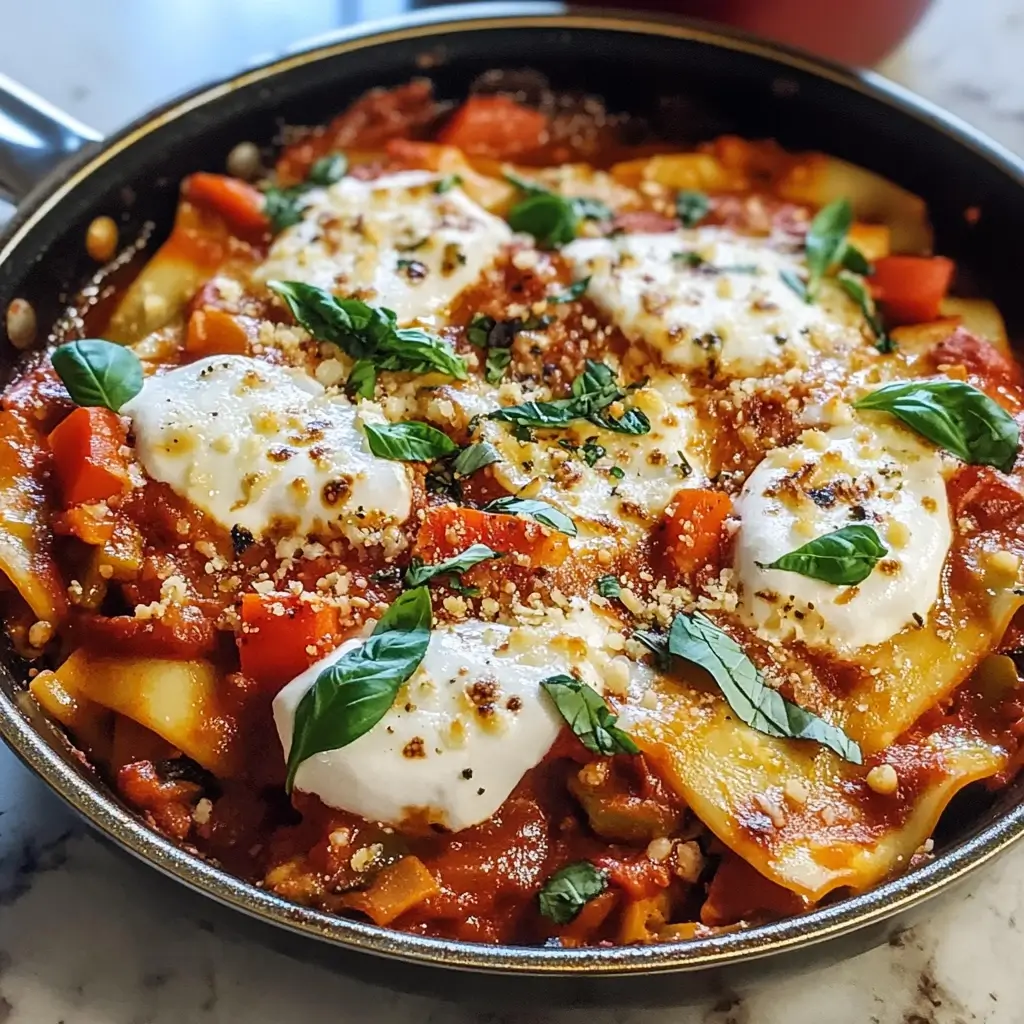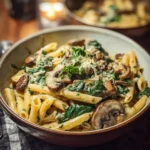Our family dinners during the summer months used to be a bit of a scramble. Between work, kids’ activities, and trying to soak up every last bit of sunshine, complex meals often fell by the wayside. Then, I stumbled upon the concept of skillet lasagna, and it was a revelation! This One-Pot Summer Vegetable Skillet Lasagna, in particular, has become an absolute hero in our household. The first time I made it, the aroma of sautéing garlic and fresh vegetables filled the kitchen, instantly drawing everyone in. My kids, who can sometimes be picky about “too many vegetables,” devoured their portions and even asked for seconds. The best part? Minimal cleanup! Just one pan means more time enjoying those precious summer evenings with loved ones, instead of scrubbing pots. It’s all the comforting, cheesy goodness of traditional lasagna without the fuss, packed with the vibrant flavors of the season. This recipe is a true celebration of summer’s bounty, and I’m thrilled to share it with you.
Ingredients: Your Summer Bounty Assembled
This recipe is designed to be flexible, embracing the best of what summer produce has to offer. The amounts below are a great starting point, but feel free to adjust based on your preferences and what’s fresh from the garden or market.
- Olive Oil: 2 tablespoons, extra virgin
- Aromatics:
- 1 large yellow onion, finely chopped (about 1 ½ cups)
- 3-4 cloves garlic, minced (about 1 tablespoon)
- Summer Vegetables (approx. 6-7 cups total, chopped):
- 1 medium zucchini, diced (about 2 cups)
- 1 medium yellow squash, diced (about 2 cups)
- 1 large bell pepper (any color – red, orange, or yellow work beautifully), cored, seeded, and diced (about 1 ½ cups)
- 1 cup fresh corn kernels (from 1-2 ears of corn, or frozen)
- 1 pint cherry or grape tomatoes, halved (about 2 cups)
- Seasonings:
- 1 teaspoon dried oregano
- 1 teaspoon dried basil (or ¼ cup fresh basil, chopped, added at the end)
- ½ teaspoon red pepper flakes (optional, for a little heat)
- Salt and freshly ground black pepper to taste
- Sauce & Liquid:
- 1 (24-28 ounce) jar good quality marinara sauce (or your favorite pasta sauce)
- 3 cups vegetable broth (or chicken broth)
- Pasta:
- 8-10 regular lasagna noodles (not no-boil), broken into 2-3 inch pieces
- Cheese Medley:
- 15 ounces whole milk ricotta cheese
- ½ cup grated Parmesan cheese, plus more for serving
- 2 cups (8 ounces) shredded mozzarella cheese (low-moisture, part-skim or whole milk)
- Fresh Garnish (optional):
- ¼ cup fresh basil leaves, chiffonade or roughly chopped
- A sprinkle of fresh parsley, chopped
Instructions: Crafting Your One-Pot Wonder
Follow these steps for a delicious and easy skillet lasagna that will have everyone asking for the recipe. Remember, the key is layering flavors and allowing the noodles to cook directly in the sauce.
- Prepare Your Skillet and Sauté Aromatics:
- Heat the olive oil in a large, deep oven-safe skillet (at least 12-inch diameter, with high sides, like a cast iron or heavy-bottomed stainless steel skillet) over medium heat.
- Once the oil is shimmering, add the chopped yellow onion. Sauté for 5-7 minutes, stirring occasionally, until softened and translucent.
- Add the minced garlic and red pepper flakes (if using). Cook for another 1-2 minutes until fragrant, being careful not to burn the garlic.
- Cook the Summer Vegetables:
- Add the diced zucchini, yellow squash, and bell pepper to the skillet. Increase the heat slightly to medium-high.
- Cook for 7-10 minutes, stirring occasionally, until the vegetables are tender-crisp and have released some of their moisture. They should be slightly browned in spots for extra flavor.
- Stir in the fresh corn kernels and halved cherry tomatoes. Cook for another 2-3 minutes, just until the tomatoes begin to soften and release their juices.
- Season and Build the Sauce Base:
- Sprinkle the dried oregano, dried basil (if using dried), salt, and freshly ground black pepper over the vegetables. Stir well to combine and cook for 1 minute more to toast the herbs.
- Pour in the marinara sauce and vegetable broth. Stir everything together thoroughly, scraping up any browned bits from the bottom of the skillet (this adds great flavor!). Bring the mixture to a gentle simmer.
- Add the Lasagna Noodles:
- Carefully submerge the broken lasagna noodle pieces into the simmering sauce. Try to arrange them in a somewhat even layer, ensuring most pieces are covered by the liquid. Gently press them down if needed. It’s okay if some poke out a bit; they will soften as they cook.
- Simmer to Perfection:
- Once the noodles are added, reduce the heat to medium-low. Cover the skillet with a lid (if your skillet doesn’t have a lid, a large baking sheet can work in a pinch).
- Simmer for 15-20 minutes, or until the lasagna noodles are al dente (cooked through but still with a slight bite). Stir gently once or twice during cooking, carefully lifting noodles from the bottom to prevent sticking, but try not to break them up too much. If the sauce seems too thick, you can add a splash more broth or water.
- Create the Cheesy Topping:
- While the lasagna simmers, you can prepare your ricotta mixture if you like (optional, but adds a classic lasagna touch). In a small bowl, combine the ricotta cheese with half of the grated Parmesan cheese (¼ cup) and a pinch of salt and pepper. Mix well.
- Once the noodles are cooked, remove the skillet from the heat.
- Layer the Cheeses and Melt:
- Dollop the ricotta mixture (if using) evenly over the surface of the lasagna. If not using a separate ricotta mixture, you can simply dollop plain ricotta.
- Sprinkle the shredded mozzarella cheese evenly over the top, followed by the remaining ¼ cup of Parmesan cheese.
- Option 1 (Stovetop): Return the lid to the skillet and let it sit off the heat for 5-7 minutes, or until the mozzarella is melted and bubbly.
- Option 2 (Broiler for extra browning – recommended if your skillet is oven-safe): Preheat your oven’s broiler to high. Place the skillet under the broiler (about 6-8 inches from the heat source) for 2-4 minutes, watching very carefully, until the cheese is melted, bubbly, and golden brown in spots. Do not walk away during this step, as it can burn quickly!
- Rest and Garnish:
- Carefully remove the skillet from the oven (if using the broiler) or take off the lid. Let the skillet lasagna rest for 5-10 minutes before serving. This allows the sauce to thicken slightly and the flavors to meld, and it will be less likely to burn your mouth!
- Sprinkle with fresh basil chiffonade and/or chopped fresh parsley just before serving, if desired.
Nutrition Facts (Estimated)
- Servings: 6-8 servings
- Calories per serving (approximate): 450-550 calories
Disclaimer: Nutritional information is an estimate and can vary significantly based on specific ingredients used (e.g., type of marinara sauce, fat content of cheeses), portion sizes, and any modifications. For precise nutritional data, consider using an online recipe calculator with your exact ingredients.
This dish is packed with vegetables, providing fiber, vitamins, and minerals. Using whole milk ricotta and mozzarella adds richness and calcium, while the lean protein from the cheese contributes to satiety. Choosing a low-sodium marinara sauce and broth can help manage sodium intake.
Preparation Time
- Prep Time: 20-25 minutes (chopping vegetables, grating cheese)
- Cook Time: 40-50 minutes
- Total Time: Approximately 1 hour to 1 hour 15 minutes
This timeline makes it a fantastic option for a weeknight meal that feels special, or a relaxed weekend lunch.
How to Serve: Elevating Your Skillet Lasagna
This One-Pot Summer Vegetable Skillet Lasagna is a star on its own, but a few simple accompaniments can make the meal even more delightful.
- Directly from the Skillet: The beauty of a one-pot meal! Place a trivet on your dining table and serve straight from the skillet for a rustic, family-style presentation.
- Individual Portions: Scoop generous portions onto individual plates or into shallow bowls.
- Garnishes are Key:
- A generous sprinkle of freshly chopped basil or parsley adds a burst of color and freshness.
- Offer extra grated Parmesan cheese at the table for those who love an extra cheesy kick.
- A drizzle of high-quality extra virgin olive oil right before serving can enhance the flavors.
- A tiny pinch of red pepper flakes for those who like it spicier.
- Perfect Pairings:
- Crusty Bread: Essential for mopping up every last bit of the delicious sauce. Garlic bread or a simple toasted baguette works wonders.
- Simple Green Salad: A light, crisp salad with a lemon vinaigrette provides a refreshing contrast to the richness of the lasagna. Think mixed greens, arugula, or romaine.
- Steamed or Roasted Green Beans: A simple side of green beans tossed with lemon zest and almonds adds another layer of green.
- Wine Pairing:
- White: A crisp Sauvignon Blanc or Pinot Grigio complements the vegetables.
- Red: A light-bodied Italian red like Chianti or Barbera works well with the tomato-based sauce.
Additional Tips for Skillet Lasagna Success
- Vegetable Versatility: Don’t be afraid to swap vegetables based on what’s in season or what you have on hand. Asparagus (add towards the end), mushrooms, spinach (stir in during the last few minutes of simmering), or even diced eggplant (sauté with other hearty veggies) would be delicious. Just be mindful of cooking times for different vegetables.
- Cheese Choices: While the ricotta, mozzarella, and Parmesan combination is classic, feel free to experiment. Smoked mozzarella could add a lovely depth, or a dollop of creamy goat cheese on top before broiling could be a tangy twist. For a creamier ricotta layer, mix the ricotta with an egg yolk and a tablespoon of cream before dolloping.
- Spice it Up or Down: Adjust the amount of red pepper flakes to your liking. You can also add a pinch of smoked paprika for a different kind of warmth, or even a dash of your favorite hot sauce to the marinara.
- Make-Ahead Components: While the full dish is best made fresh, you can save time by chopping all your vegetables a day in advance and storing them in an airtight container in the refrigerator. You can also pre-grate your cheeses.
- Noodle Know-How: Ensure your lasagna noodles are mostly submerged in the liquid to cook properly. If the mixture looks too dry during simmering, add a bit more broth or water ¼ cup at a time. Regular lasagna noodles work best here; no-boil noodles can sometimes become too mushy in this one-pot application.
FAQ Section: Your Skillet Lasagna Questions Answered
Q1: Can I make this recipe gluten-free?
A1: Yes, absolutely! Substitute the regular lasagna noodles with your favorite gluten-free lasagna noodles. Break them into pieces just like the regular ones. Keep an eye on the cooking time, as gluten-free pasta can sometimes cook faster or require a bit more liquid. Ensure your marinara sauce and broth are also certified gluten-free.
Q2: Can I add meat to this skillet lasagna?
A2: Certainly! If you’d like to add meat, brown 1 pound of ground Italian sausage, ground beef, or ground turkey after sautéing the onions and garlic, but before adding the other vegetables. Drain off any excess fat before proceeding with the recipe. This will make it a heartier, non-vegetarian meal.
Q3: How do I store and reheat leftovers?
A3: Store any leftover skillet lasagna in an airtight container in the refrigerator for up to 3-4 days. To reheat, you can microwave individual portions until heated through. Alternatively, for larger amounts, you can gently reheat it in a skillet on the stovetop over low heat, adding a splash of water or broth if it seems dry, until warm. You can also reheat it in an oven-safe dish at 350°F (175°C) until heated through.
Q4: What’s the best type of skillet to use for this recipe?
A4: A large (at least 12-inch diameter), deep, heavy-bottomed skillet is ideal. Cast iron skillets work wonderfully as they retain heat evenly and can go from stovetop to broiler. A deep sauté pan or a Dutch oven would also be suitable. Make sure it has a lid, or you have something to cover it with. If you plan to use the broiler, ensure your skillet is oven-safe (including the handle!).
Q5: My noodles are sticking to the bottom or not cooking evenly. What did I do wrong?
A5: This can happen for a few reasons. First, ensure you have enough liquid; the noodles need to be mostly submerged to cook properly. If the sauce seems too thick initially, add a bit more broth. Second, stir gently once or twice during the simmering process, carefully dislodging any noodles from the bottom. Don’t over-stir, or the noodles might break apart too much. Finally, maintain a gentle simmer, not a rolling boil, as too high heat can cause sticking and uneven cooking.

One-Pot Summer Vegetable Skillet Lasagna Recipe
Ingredients
- Olive Oil: 2 tablespoons, extra virgin
- Aromatics:
- 1 large yellow onion, finely chopped (about 1 ½ cups)
- 3–4 cloves garlic, minced (about 1 tablespoon)
- Summer Vegetables (approx. 6-7 cups total, chopped):
- 1 medium zucchini, diced (about 2 cups)
- 1 medium yellow squash, diced (about 2 cups)
- 1 large bell pepper (any color – red, orange, or yellow work beautifully), cored, seeded, and diced (about 1 ½ cups)
- 1 cup fresh corn kernels (from 1–2 ears of corn, or frozen)
- 1 pint cherry or grape tomatoes, halved (about 2 cups)
- Seasonings:
- 1 teaspoon dried oregano
- 1 teaspoon dried basil (or ¼ cup fresh basil, chopped, added at the end)
- ½ teaspoon red pepper flakes (optional, for a little heat)
- Salt and freshly ground black pepper to taste
- Sauce & Liquid:
- 1 (24-28 ounce) jar good quality marinara sauce (or your favorite pasta sauce)
- 3 cups vegetable broth (or chicken broth)
- Pasta:
- 8–10 regular lasagna noodles (not no-boil), broken into 2-3 inch pieces
- Cheese Medley:
- 15 ounces whole milk ricotta cheese
- ½ cup grated Parmesan cheese, plus more for serving
- 2 cups (8 ounces) shredded mozzarella cheese (low-moisture, part-skim or whole milk)
- Fresh Garnish (optional):
- ¼ cup fresh basil leaves, chiffonade or roughly chopped
- A sprinkle of fresh parsley, chopped
Instructions
- Prepare Your Skillet and Sauté Aromatics:
- Heat the olive oil in a large, deep oven-safe skillet (at least 12-inch diameter, with high sides, like a cast iron or heavy-bottomed stainless steel skillet) over medium heat.
- Once the oil is shimmering, add the chopped yellow onion. Sauté for 5-7 minutes, stirring occasionally, until softened and translucent.
- Add the minced garlic and red pepper flakes (if using). Cook for another 1-2 minutes until fragrant, being careful not to burn the garlic.
- Cook the Summer Vegetables:
- Add the diced zucchini, yellow squash, and bell pepper to the skillet. Increase the heat slightly to medium-high.
- Cook for 7-10 minutes, stirring occasionally, until the vegetables are tender-crisp and have released some of their moisture. They should be slightly browned in spots for extra flavor.
- Stir in the fresh corn kernels and halved cherry tomatoes. Cook for another 2-3 minutes, just until the tomatoes begin to soften and release their juices.
- Season and Build the Sauce Base:
- Sprinkle the dried oregano, dried basil (if using dried), salt, and freshly ground black pepper over the vegetables. Stir well to combine and cook for 1 minute more to toast the herbs.
- Pour in the marinara sauce and vegetable broth. Stir everything together thoroughly, scraping up any browned bits from the bottom of the skillet (this adds great flavor!). Bring the mixture to a gentle simmer.
- Add the Lasagna Noodles:
- Carefully submerge the broken lasagna noodle pieces into the simmering sauce. Try to arrange them in a somewhat even layer, ensuring most pieces are covered by the liquid. Gently press them down if needed. It’s okay if some poke out a bit; they will soften as they cook.
- Simmer to Perfection:
- Once the noodles are added, reduce the heat to medium-low. Cover the skillet with a lid (if your skillet doesn’t have a lid, a large baking sheet can work in a pinch).
- Simmer for 15-20 minutes, or until the lasagna noodles are al dente (cooked through but still with a slight bite). Stir gently once or twice during cooking, carefully lifting noodles from the bottom to prevent sticking, but try not to break them up too much. If the sauce seems too thick, you can add a splash more broth or water.
- Create the Cheesy Topping:
- While the lasagna simmers, you can prepare your ricotta mixture if you like (optional, but adds a classic lasagna touch). In a small bowl, combine the ricotta cheese with half of the grated Parmesan cheese (¼ cup) and a pinch of salt and pepper. Mix well.
- Once the noodles are cooked, remove the skillet from the heat.
- Layer the Cheeses and Melt:
- Dollop the ricotta mixture (if using) evenly over the surface of the lasagna. If not using a separate ricotta mixture, you can simply dollop plain ricotta.
- Sprinkle the shredded mozzarella cheese evenly over the top, followed by the remaining ¼ cup of Parmesan cheese.
- Option 1 (Stovetop): Return the lid to the skillet and let it sit off the heat for 5-7 minutes, or until the mozzarella is melted and bubbly.
- Option 2 (Broiler for extra browning – recommended if your skillet is oven-safe): Preheat your oven’s broiler to high. Place the skillet under the broiler (about 6-8 inches from the heat source) for 2-4 minutes, watching very carefully, until the cheese is melted, bubbly, and golden brown in spots. Do not walk away during this step, as it can burn quickly!
- Rest and Garnish:
- Carefully remove the skillet from the oven (if using the broiler) or take off the lid. Let the skillet lasagna rest for 5-10 minutes before serving. This allows the sauce to thicken slightly and the flavors to meld, and it will be less likely to burn your mouth!
- Sprinkle with fresh basil chiffonade and/or chopped fresh parsley just before serving, if desired.
Nutrition
- Serving Size: One Normal Portion
- Calories: 450-550





